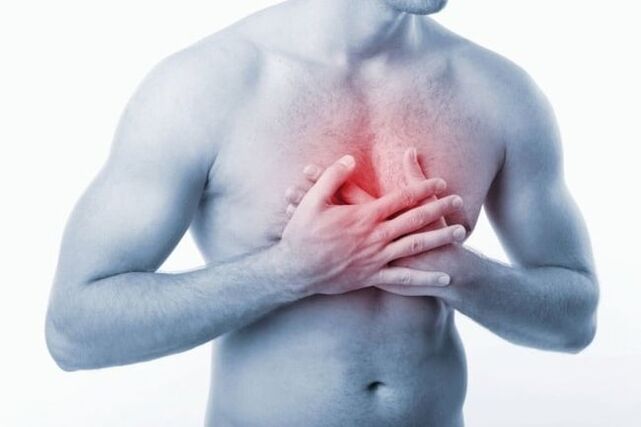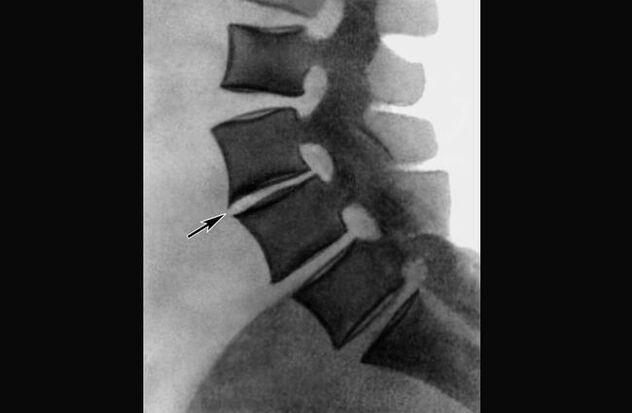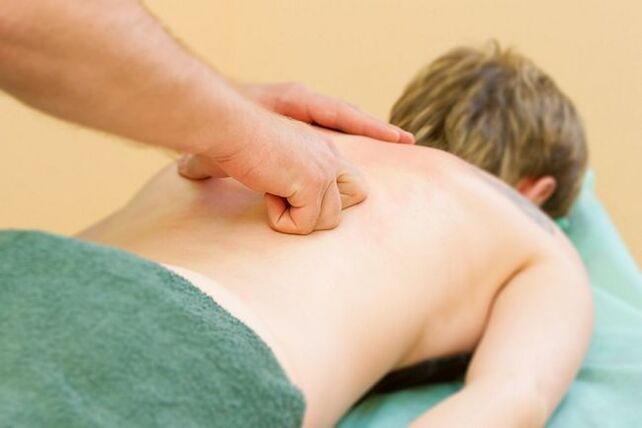Osteochondrosis is one of the most common diseases of the spine. It usually occurs in many people over the age of forty, but it often occurs in younger people as well. Osteochondrosis is included in ICD-10, code M42 (codes M40-M43 - deforming dorsopathy)
Osteochondrosis is the layering of the intervertebral discs, as a result of which they become flatter and reduce the total height of the spinal column. Deformed intervertebral discs lead to pinched nerves and pain. Osteochondrosis of the thoracic region is relatively rare, since this area of 12 vertebrae is well anchored by the ribs and sternum. The disease usually affects the upper vertebrae of the class.
Causes of thoracic osteochondrosis
This disease most often occurs in people who have a family history of osteochondrosis, but there are exceptions. The appearance of the disease can lead to:
- congenital pathologies of the spine;
- injury;
- constant vigorous physical activity;
- severe metabolic disorders;
- general muscle weakness;
- infections and frequent temperature changes;
- constant stress.
Osteochondrosis appears in many women during menopause.
Signs of osteochondrosis of the thoracic spine
The symptoms of this disease can be different, a lot depends on the age of the patient, the extent and stage of the disease. During remission, the disease is practically imperceptible, but during exacerbation it is impossible not to notice it.

Pathological changes in the spine appear with the following symptoms:
- sharp or aching pain in the chest, in the region of the spinal column (dorsago);
- if the nerve roots exiting the spinal cord are damaged (radiculopathy), shooting pains, paresthesias, and various sensory disturbances occur;
- there is an aching pain in the region of the heart, which does not disappear after taking glycerine trinitrate;
- pulmonary syndrome, which can be identified by signs of oxygen starvation and poor ventilation;
- acute pain in the abdomen;
- pain in osteochondrosis of the thoracic spine is not accompanied by fever, as is often the case with back pain;
- the pain syndrome increases with pressure on the vertebrae;
- compression myelopathy may develop. Myelopathy is characterized by changes in the sensitivity of the skin and muscles near the affected area of the spine.
Important! Osteochondrosis of the chest and lumbar region often simulates diseases of the internal organs. Patients may experience stomach, liver, and heart pain due to pinched nerves. Over time, "supposed" diseases can actually appear due to persistent inflammation.
If the patient feels pain in the internal organs, but pain is the only symptom, the condition of the spine should be checked. Thus, for example, the tenth vertebra is responsible for the innervation of the kidneys and the general condition of the body. With osteochondrosis, a person feels pain in the kidneys and gets tired quickly. That is why it is important not to self-medicate, as is often advised on various forums, but to consult a specialist.

Stages of osteochondrosis of the thoracic region
The international classification established 4 stages (degrees) of osteochondrosis of the thoracic region, each of which has its own clinical picture:
1 degree.At this stage, the disease appears only as a result of the intervertebral disc losing moisture, its height decreases, the vertebrae come closer to each other and begin to compress the nerves. The patient may feel a local pain syndrome in the region of the patient's vertebrae, and sometimes characteristic backaches occur. Painful sensations occur with active movement and physical exertion, but some exercises can relieve discomfort. Usually, the 1st degree of the disease is taken for ordinary fatigue, so people do not rush to the doctor.
2 degrees.The vertebra loses its stability and the annulus fibrosus cracks. Due to the increase in instability, both obvious and hidden subluxations can occur, which can cause a lot of trouble in the future. The patient experiences pain not only during physical exertion, but sometimes also when standing (for example, lying on his side or back). Grade 2 osteochondrosis is characterized by general weakness and increased fatigue, and pain can be observed in the area of the internal organs, in the limbs. Thoracalgia may occur.
3 degrees.The fibrous ring thins and cracks, which causes a herniated disc. Such a disease causes many deviations in the work of internal organs, since the spine is in a curved state and severely limits movement, forcing a person to take positions in which pain is less felt. The pain syndrome is very strong, at this stage the formation of the spine with radicular syndrome is possible.
4 degrees.The vertebrae begin to increase in width, their processes ossify, and the remains of the intervertebral discs also ossify. Patients often notice a reduction in pain, but the mobility of the spine is also significantly reduced. Vertebrae come closer to each other, ossify and their roots grow, which reduces the amortization capacity of the spine. A person suffering from advanced osteochondrosis noticeably loses his height, his movement becomes limited, spinal curvature (kyphosis or lordosis) is observed.
Against the background of osteochondrosis of the thoracic spine, various diseases of the internal organs can develop, so it is dangerous to delay diagnosis and treatment.
Diagnostic methods
The main radiological signs of the disease are:
- irregular outline of the intervertebral disc;
- The wavy edge of the integument plates;
- The hook-shaped processes are enlarged and pointed;
- Reduced height of the intervertebral discs;
- The shape of the intervertebral discs has changed;
- Herniated intervertebral discs (it is easier to determine anterior herniations);
- Occurrence of osteophytes;
- The shape of the vertebral body changes.
In some cases, an X-ray contrast examination is performed - discography, which shows the following characteristics:
- irregular outline of the nucleus pulposus;
- In the severe stage of the disease, the intervertebral disc is completely filled with contrast;
- With significant destruction of the disc, contrast is observed, which exceeds its limits, sometimes falling into the spinal canal.
Consequences of osteochondrosis
If the disease is not treated, the progression of the disease is very fast. But with successful treatment, the number of possible complications is minimal. Osteochondrosis has several main complications:
- Sciatica
- Spondylosis of the thoracic spine (and other departments).
- VSD
- Impaired hearing or vision
- Radiculitis
- Migraine
- Lumbago
- Intervertebral rust
- Spondylarthrosis
- Disability
- Thoracalgia
- epicondylitis
The main methods of treatment of osteochondrosis of the thoracic spine
Now the treatment of thoracic osteochondrosis is carried out by the following methods:
- Conservative treatment
- Surgical treatment
- traction

Medical treatment is based on several principles. The main thing is to fight pain and reduce inflammation. Therefore, doctors use anti-inflammatory drugs to eliminate pain.
To improve the condition of the cartilage, doctors prescribe prescription chondroprotectors to patients.
Restrictions on the movement of the spine are often caused by tight muscles. In order to get rid of the disease, doctors prescribe muscle relaxants and antispasmodics.
To reduce pain, doctors recommend that patients use various ointments for osteochondrosis that have a warming effect.
For the effective treatment of the disease, it is important that the medicine is regulated by a doctor. The patient must remember that the medicines must be taken strictly in the order given by the doctor. Medicines cannot be mixed or replaced with analogues without the consent of the attending physician.
In addition to medical treatment, doctors prescribe acupuncture, reflexology, physiotherapy, and therapeutic massage. All these treatments should be discussed in detail with your doctor and should be carried out by a specialist.
In the early stages of the disease, the entire treatment process for osteochondrosis of the thoracic spine is limited to physiotherapy exercises for osteochondrosis and a number of special exercises. Drug therapy consists of the prescription of drugs that improve metabolism, as well as vitamin therapy.
Patients are advised not to exercise without consulting their doctor. It should be noted that gymnastics cannot be done during the acute stage of the disease. Any exercise therapy is selected depending on the location of the damaged area of the spine. Folk remedies can also be used.
What to do when the disease worsens?
Aggravation of osteochondrosis is always accompanied by pain. Thus, the main goal of treatment is to reduce pain.
NSAIDs are prescribed for this. They reduce the production of prostaglandins, which irritate the nerve endings responsible for pain. In case of ineffectiveness of these drugs, blockade with local anesthetics can be used. In addition, heavy physical exertion should be avoided during the exacerbation of the disease, rest is recommended. Therefore, in such situations, exercises performed with osteochondrosis of the chest region are contraindicated until further decision of the attending physician.

Preventive measures
In order to prevent the development of osteochondrosis of the thoracic spine, you should always take care of your health.
The first step is to eliminate all the factors that can trigger the development of osteochondrosis, do not forget about the danger of heavy physical exertion and maintaining the correct posture.
Every person must undergo a regular check-up at a special clinic. If during the medical examination the doctor found primary pathologies of the spine, the patient should immediately consult an orthopedist.
In order to prevent the disease, all diseases must be treated in time, and this is especially important for diseases of the musculoskeletal system. Mandatory rehabilitation must be carried out after injuries.

Take care of your body: change your position more often during work to avoid hypothermia and overheating, do not forget about medical examinations.
At home, people can't always keep their body in the right tone, as it can be done in the gym. But don't forget to strengthen your back muscles with various exercises. So, for example, physiotherapy exercises for osteochondrosis help very well. The point is not to overdo it. And photos and videos of the exercises are easy to find online.
The best prevention of all diseases is a balanced diet. The diet should not only contain vegetables, but also a complex of vitamins, which is especially important in the spring-winter period. To strengthen the back, you can use massage, medicine, swimming.


























